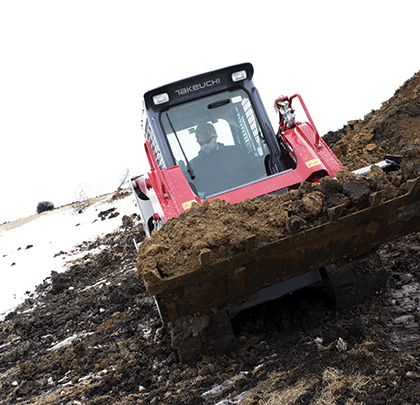Whether you’re using your compact equipment during winter or putting it in storage for a few months, it is critical that your equipment is prepared for both situations.
Preventive maintenance goes a long way to protect your investment. You should perform preventive maintenance at the beginning, as well as at the end, of each working season. A little bit of maintenance goes a long way to ensure your equipment is ready to roll once spring comes around.
PREPPING FOR WINTER TIME
Many of you might continue to use your equipment during winter instead of putting machines in storage. While you’re capitalizing on your investment by using the equipment year-round, it is important to take basic maintenance measures to ensure your equipment runs reliably through the harsh conditions winter can throw at you.
First, it is important that you change your fluids and lubricants to cold tolerant products approved to handle the extreme conditions in which your machine will be operating.
Always reference your operator’s manual for recommended specifications, and contact your dealer with any questions. For proper lubrication, it’s important to use low-temperature grease on pivot joints and an engine oil viscosity that matches the outside operating temperatures. Replace fuel and hydraulic filters, which have likely gathered moisture, dirt, and debris from the summertime.
It’s important to start filling your equipment with an anti-gel fuel before freezing conditions set in. To minimize the risk of frozen or gelled up fuel lines, first check the operator’s manual and, if possible, use manufacturer-approved fuel additives.
NEW EMISSIONS SYSTEMS
Owners also need to be aware of the new EPA compliant engines that are powering their machines and how that affects winter operations. Many newer model machines are utilizing Tier 4 emissions systems; these include a Diesel Particulate Filter (DPF) with a regeneration process that converts the soot buildup in the DPF to an ash byproduct. As a result of this, owners will not be able to idle their machines in cold weather for long periods of time, as idling will cause the DPF to soot up and clog. This may ultimately result in a dealer service call to rectify the problem.
ADDITIONAL CHECKLIST PREPARATIONS
Winter can also be tough on your hydraulic system and attachments. Check hoses and connections regularly. A loose connection could cause moisture to build up inside, potentially causing the internal components of the machine to freeze and possibly burst the hoses.
Changing temperatures from warm to cold to freezing will deflate your tires a little air at a time, so check the tires regularly and check your operator’s manual for the proper psi. During the winter, batteries die because they need to generate nearly twice the amount of amps to turn over a cold engine. Check your battery connections for corrosion and wear that leads to hard-starting problems. Also, make sure to perform a load test on your batteries before winter begins.
Be sure to check the heating and defrosting systems before winter starts as part of your routine maintenance. Also, make sure to check that the cab door and window are sealed tightly, letting no cold air inside the cab. While this won’t have any affect on how the equipment operates, it will help the operator stay warm.
When switching seasons, a little preventive maintenance allows you to get the most return on your investment instead of having winter throw a wrench in your plans.
STORING YOUR COMPACT EQUIPMENT
It is important to create a checklist during the winterization process to ensure you don’t miss a beat. The last thing you want is for your equipment to fail when you bring it out of storage the next busy season because you forgot a few steps on the checklist.
First, it is important to store your machines in a dry, dust-free environment for the duration of the off-season. If you don’t have dry, dust-free storage, there are additional measures you can take to make sure dust and moisture don’t settle in the important components and electrical connections. It is also advantageous to keep your equipment out of direct sunlight. This is because constant temperature changes can cause condensation to form on metal parts, which can then freeze and cause damage to internal components.
Your compact equipment worked hard in the summer, so it is important to give the machine a thorough washing and cleaning before putting it away for the next few months. After a wash, look closely for any dirt or debris in the undercarriage. Next, apply an anti-corrosion protective coating to the exposed cylinder rods. It is also important to put protective covers on the air intake hose and the muffler during any long-term storage, especially if the storage is not a dry, dust-free area.
After driving the compact equipment to where you want to store it, make sure to disconnect the battery and store it in a clean and dry environment. Keeping it in a clean and dry environment will keep moisture from ruining the battery.
By ensuring that you took the right preventive measures during the winterization process, you will be happy come spring after bringing your compact equipment out of its’ winter slumber. ■
About The Author
Gary Bryan is the national warranty manager at Takeuchi-US, a pioneer in the compact equipment industry since 1963. For more information about Takeuchi, visit www.takeuchi-us.com.
Modern Contractor Solutions, December 2014
Did you enjoy this article?
Subscribe to the FREE Digital Edition of Modern Contractor Solutions Magazine!



